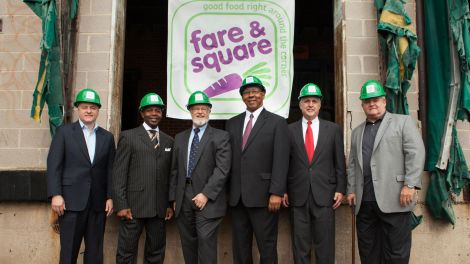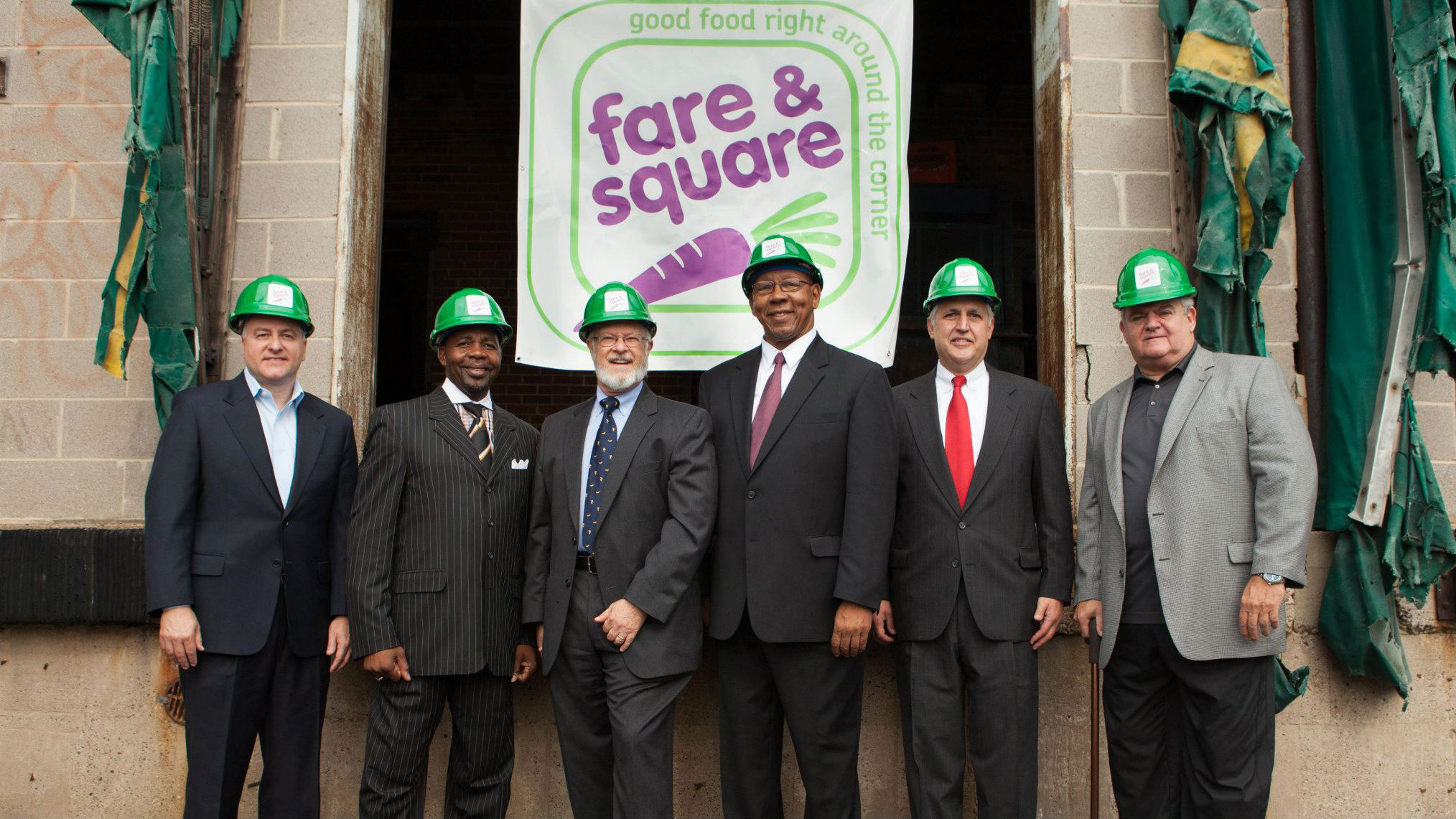
Fare and SquareIt took the nonprofit Philabundance to open a grocery store in Chester, Penn., but that’s just the first step in getting locals to eat better food.
Last year, Whole Foods built a new store in Detroit, to great acclaim and excitement. It deserved at least some of the attention: This was the first national chain to open a grocery store in Detroit — often cited as a food desert — in over a decade. But some of the hoopla came from the fact that the store seemed to confirm a satisfying, but simplistic, narrative, which goes something like this:
There are tons of people in urban food deserts yearning for fresh fruits and vegetables, but the blinkered (and maybe prejudiced) grocery executives don’t want these people as their customers. Cast off those blinkers and everyone wins: The grocery stores profit by meeting the demand for good food, the people switch from fast food to root-vegetable stews, and unicorns paint the sky with rainbows.
Whole Foods in Detroit looks like it proves the point that people are just waiting in food deserts to buy bundles of arugula. The store “is exceeding our wildest expectations,” Whole Foods Market Co-CEO Walter Robb said. But they set those expectations pretty low, with much smaller margins then they normally see. And Whole Foods only came in after the plunging population had stabilized and the city became a destination for a young, middle-class demographic.
“Suddenly cities are cool again, and people are moving back, and there’s lots of interest in getting grocery stores into urban areas,” said Alphonzo Cross, co-owner of Boxcar Grocer in Atlanta. “Nobody gave a shit 20 years ago.”
Nobody, that is, except for the people who were living in those neighborhoods. In 2013, as Whole Foods was opening, another store across town, the locally owned and operated Metro Foodland, was getting ready for its 30th year in business. It had opened in the midst of Detroit’s depopulation and found a way to thrive while offering healthy foods, year after year.
The problem with the quick-fix narrative is that, put simply, it’s wrong. It’s not that grocery executives turn up their noses at poorer neighborhoods; they just couldn’t figure out how to make money there. The narrative also goes wrong in assuming that people will change their food habits as soon as they have access to brown rice. This simplistic vision of the quick fix disrespects the people who have tackled this problem in a much more sophisticated way and found real solutions.
So when Brahm Ahmadi, of the People’s Community Market, started trying to figure out how to open a grocery in the chronically underserved neighborhood of West Oakland, he went to James Hooks, who started Metro Foodland, and asked for advice.
“Jim was pretty honest with us about how hard it is,” Ahmadi said. But he also learned there was a way, if he was willing to work hard, to capitalize on opportunities the big grocery chains had missed.
Give the people what the people want
The first key to success, for any company, is to offer your customers something they’d actually buy. When Fare and Square, a nonprofit grocery store in Chester, Penn., first opened up, its members told the store managers that the gluten-free and low-sugar items on the shelf felt “a little too chi chi — it felt too gourmet,” said Marlo DelSordo, a spokesperson for Philabundance, the organization that runs Fare and Square. They’d always put community engagement and trust first, DelSordo said, so they gave the people the products they were used to.
“People say they want fruits and vegetables,” said Alphonzo Cross, “but they want to see fruits and vegetables, not buy fruits and vegetables.”
Having that beautiful spread of produce tells customers that they are in a quality establishment — but it doesn’t mean they are suddenly going to start cooking with a lot of produce. “People are breaking down my door for healthy snack bars, chips, dog food, toilet paper,” Cross said. “No one is breaking down my door for bananas.”
Even Whole Foods altered its product mix in Detroit, offering fewer organic items and instead emphasizing local foods.
Stores can’t force their customers to buy healthier foods, Ahmadi said. Instead, you have to draw people in by giving them what they want, then get them to demand healthier products.
Metro Foodland, for example, offers a lot of information about health. It has partnered with a chef to provide classes and healthy shopping lists. It has a small community room full of events. And the store has a rewards card that gives members money back on healthy foods, creating a subtle push toward those items.
Small is beautiful
One major reason grocery stores have been reluctant to locate in cities is that it’s simply hard to find the space. Those big stores have a big footprint, and assembling the real estate in a dense urban area can be a multi-year headache. It’s a lot simpler (not to mention cheaper) to start small.
But being small requires a complete reorganization of the supermarket business strategy. The business model of the modern supermarket emerged as the country became dependent on cars. It’s a model that thrives on high volume and low margins. In the average American supermarket, each shopper will walk out with $75 worth of groceries, Ahmadi said. People shop for a week at a time and move the bags directly from cart to car.
In cities, especially in lower-income neighborhoods, however, people don’t buy as much per trip — less than $20. Almost half of the households in West Oakland have no car, so people take public transportation, or cabs, to get to the store. Almost a third of the food budget in these car-less households goes to transportation to and from the grocery store. But here’s the thing: Those people are going to the store much more frequently and spending almost as much as their more affluent neighbors. When doing feasibility studies, Ahmadi learned that (down at the heels) West Oakland spends $60 million a year on groceries, while the nearby (and very bougie) neighborhood of Rockridge spends $65 million. Surely, Ahmadi thought, this neighborhood could support a grocery with the right business model.
That model calls for a lot fewer items in a smaller space, and an intense engagement with customers to make sure those are the products that will sell. It’s still a low margin, high-volume game; it just concentrates all those sales into a smaller number of products.
Going small can also mean small profits. A lot of the people I tried to contact for this story told me they were busy and would try to get back to me … later. I talked to Cross while he was at work, running the store and signing off on deliveries. There just isn’t enough wiggle room to hire many employees. And because he never wants to buy 40 pallets of chips at a time, Cross has a hard time finding mainstream suppliers who want to do business with him. Boxcar Grocer has been in business for two years now, and it is making money, he said, but they aren’t getting rich.
One way of counteracting these problems, Cross said, is to be both big and small at the same time. That is, have lots of small stores scattered through the city. But investors are still wary. “All the money is going toward getting large supermarkets to rock and roll out in the suburbs,” Cross said. So for now it’s just a few entrepreneurs and nonprofits showing that the model works.
Be patient
If you’re tight on cash, don’t have a car, and are paying for a cab to make a rare, larder-filling trip to the grocery store, you’re probably going to be very picky about the products you choose. You’re probably going to want foods that won’t rot, and that will, first and foremost, fill hungry bellies. You’re probably going to opt for things that are shelf-stable and calorie dense. And if you grew up eating this way, you aren’t going to start buying different products if a grocery store opens up nearby.
“Cultural change takes a long time,” Ahmadi said. “It’s taken a couple of generations to get to this point with our diets. It may take another decade before we see truly healthier eating.”
Cross put it a little more colorfully: “Food retail in the U.S. is all jacked up.” It’s going to take some time before urban stores develop to be a link in a robust chain connecting farmers to people who have lacked access to good food.
But the proof of concept is already there. Sure, you can see it in Whole Foods, Detroit. But you can see it even more clearly in Metro Foodland, or Boxcar Grocer, or any of the places so busy getting it done that they didn’t have time to talk to me.




